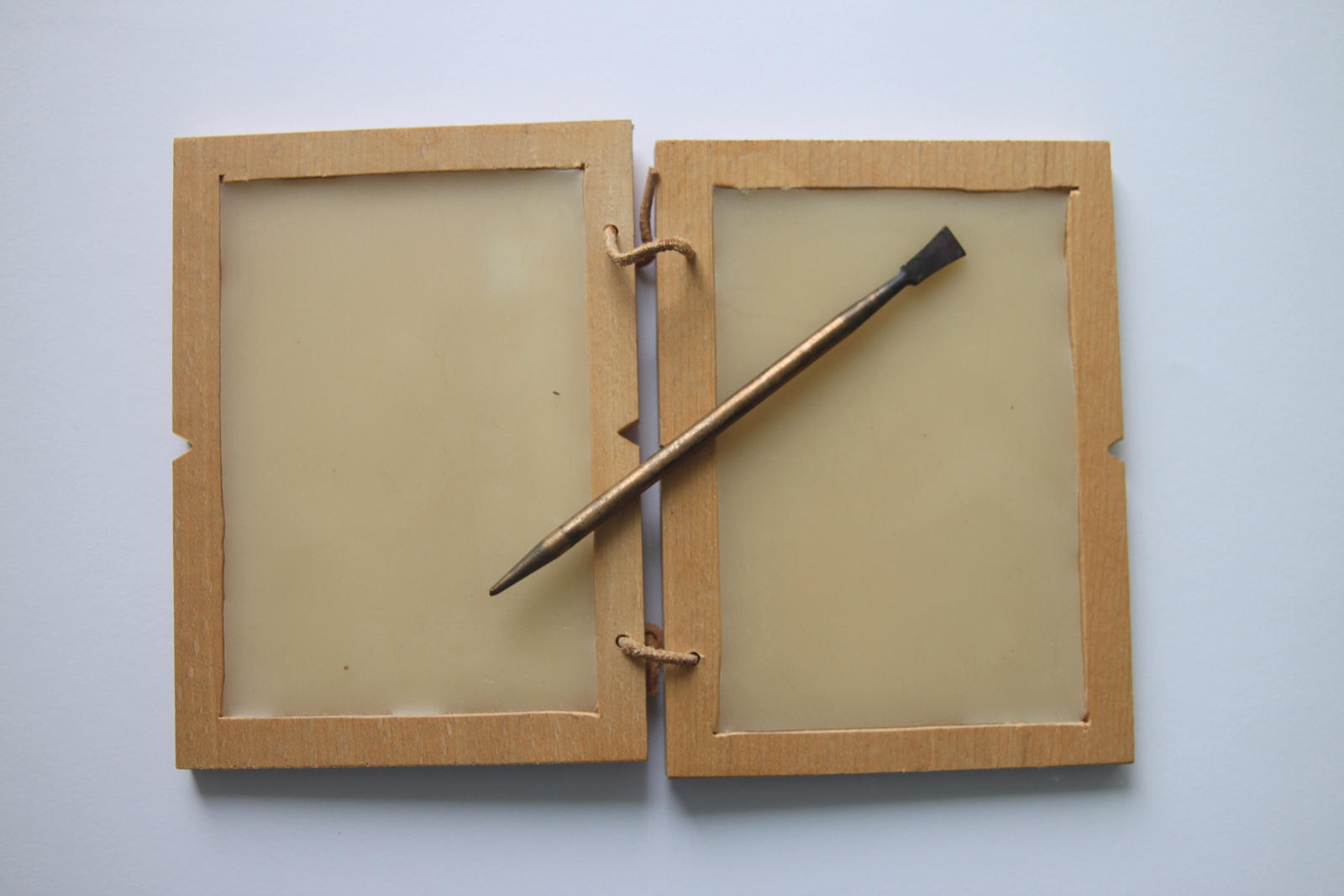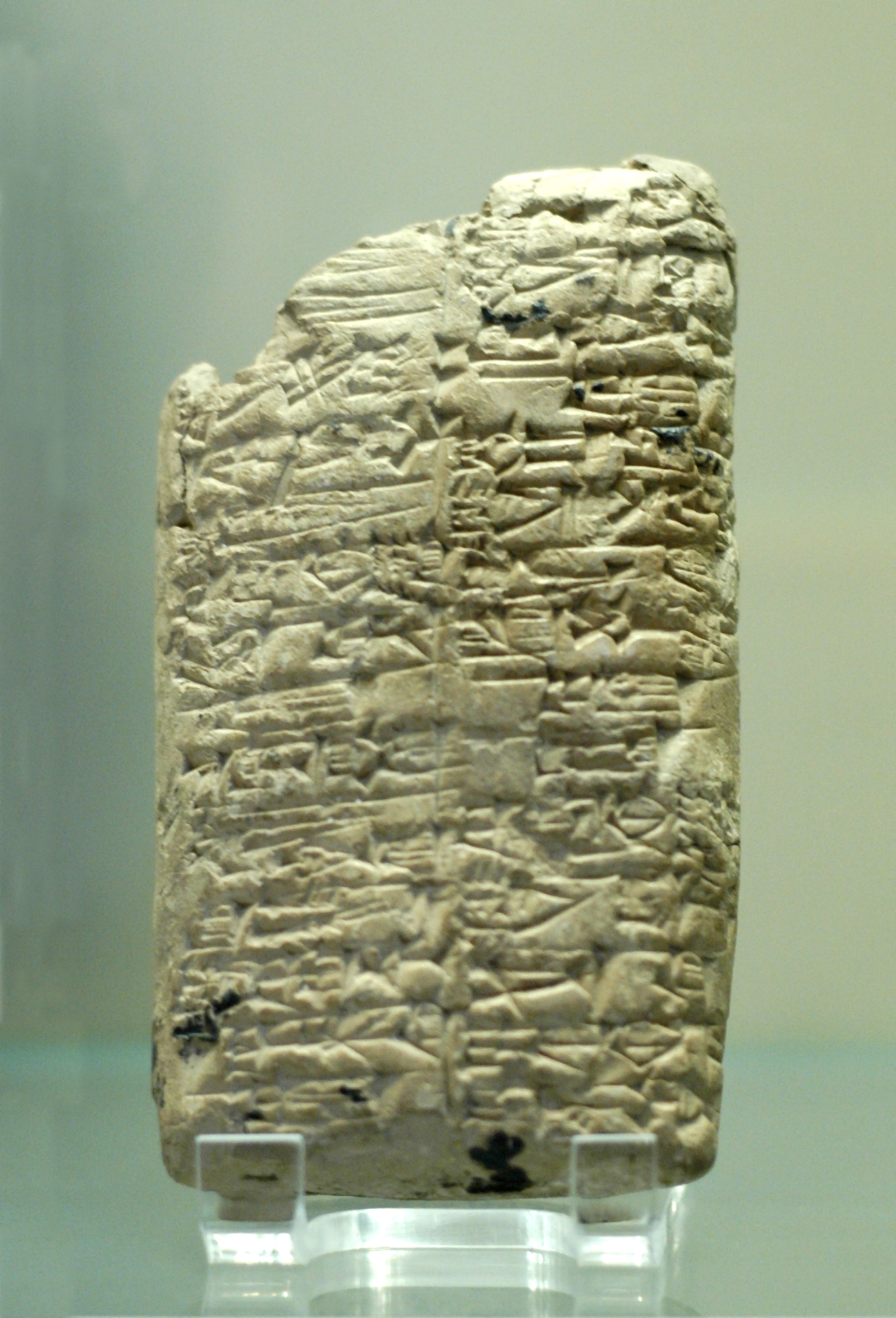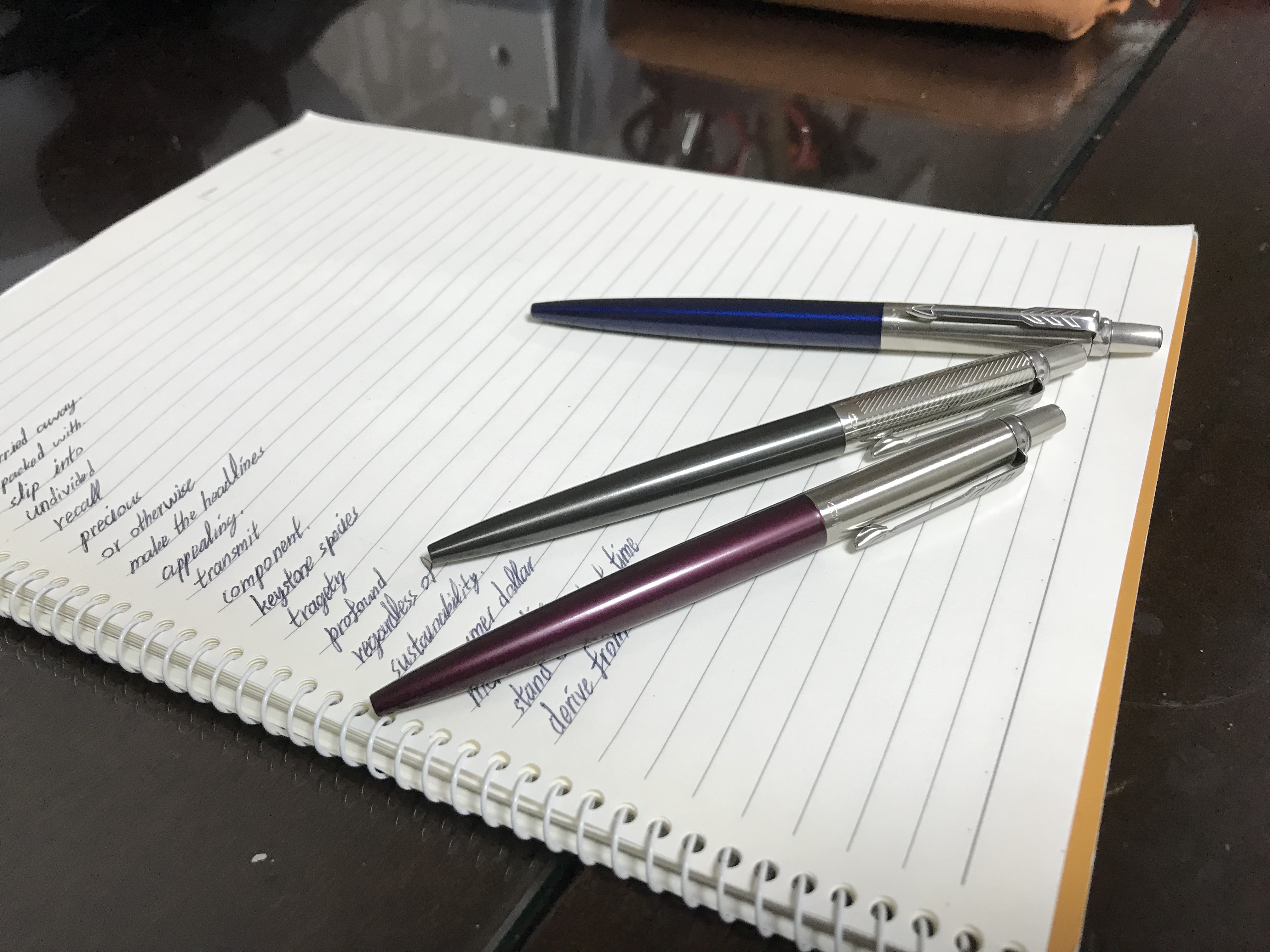|
Stylus
A stylus is a writing utensil or tool for scribing or marking into softer materials. Different styluses were used to write in cuneiform by pressing into wet clay, and to scribe or carve into a wax tablet. Very hard styluses are also used to Engraving, engrave metal, and the slate and stylus system is used to punch out dots to write in Braille. Styluses are held in the hand and thus are usually a narrow elongated shape, similar to a modern ballpoint pen. Many styluses are heavily curved to be held more easily. The word ''stylus'' is also used to describe Stylus (computing), computer styluses used to assist in navigating or providing more precision when using touchscreens. Etymology ''Stylus'' comes from the Latin —the spelling ''stylus'' arose from an erroneous connection with Greek (), 'pillar'.''Oxford Latin Dictionary'', s.v. "stilus" (2012). The Latin word had several meanings, including "a long, sharply pointed piece of metal; the stem of a plant; a pointed instrume ... [...More Info...] [...Related Items...] OR: [Wikipedia] [Google] [Baidu] |
Stylus (computing)
In computing, a stylus (or stylus pen) is a small pen-shaped instrument whose tip position on a computer monitor can be detected. It is used to draw, or make selections by tapping. While devices with touchscreens such as laptops, smartphones, game consoles, and graphics tablets can usually be operated with a fingertip, a stylus can provide more accurate and controllable input. History The earliest computer-related usage for a stylus was in 1643 with Pascal's calculator. The device had rotary dials that rotated in accordance with the selected numbers; with gears, drums, and clever engineering, it was capable of addition, subtraction, multiplication and division (using 9's constant). A stylus was used to turn the dials. Later devices of this type include the Arithmometer, in the 1860s; and the Addiator, in 1920. The Addiator was a pocket mechanical adding machine that used a stylus to move tiny rigid slices of sheet-metal that were enclosed in a case. On the side of a slic ... [...More Info...] [...Related Items...] OR: [Wikipedia] [Google] [Baidu] |
Slate And Stylus
The slate and stylus are tools used by blind people to write text that they can read without assistance.Alpha Chi Omega (1908) Invented by Charles Barbier as the tool for writing letters that could be read by touch, the slate and stylus allow for a quick, easy, convenient and constant method of making embossed printing for Braille character encoding. Prior methods of making raised printing for the blind required a movable type printing press. Design The basic design of the slate consists of two pieces of metal, plastic, or wood fastened together with a hinge at one side.Harry Houdini Collection (1888) The back part of the slate is solid with slight depressions spaced in braille cells of six dots each. The depressions are approximately deep and about in diameter. The horizontal and vertical spacing between dots within a cell is approximately , while the distance between adjacent cells is about . The front of the slate consists of rectangular windows that fit over the bra ... [...More Info...] [...Related Items...] OR: [Wikipedia] [Google] [Baidu] |
Touchscreen
A touchscreen (or touch screen) is a type of electronic visual display, display that can detect touch input from a user. It consists of both an input device (a touch panel) and an output device (a visual display). The touch panel is typically layered on the top of the electronic visual display of a device. Touchscreens are commonly found in smartphones, tablet computer, tablets, laptops, and other electronic devices. The display is often an Liquid-crystal display, LCD, AMOLED or OLED display. A user can give input or control the information processing system through simple or multi-touch gestures by touching the screen with a special Stylus (computing), stylus or one or more fingers. Some touchscreens use ordinary or specially coated gloves to work, while others may only work using a special stylus or pen. The user can use the touchscreen to react to what is displayed and, if the software allows, to control how it is displayed; for example, Zooming user interface, zooming to inc ... [...More Info...] [...Related Items...] OR: [Wikipedia] [Google] [Baidu] |
Cuneiform
Cuneiform is a Logogram, logo-Syllabary, syllabic writing system that was used to write several languages of the Ancient Near East. The script was in active use from the early Bronze Age until the beginning of the Common Era. Cuneiform scripts are marked by and named for the characteristic wedge-shaped impressions (Latin: ) which form their Grapheme, signs. Cuneiform is the History of writing#Inventions of writing, earliest known writing system and was originally developed to write the Sumerian language of southern Mesopotamia (modern Iraq). Over the course of its history, cuneiform was adapted to write a number of languages in addition to Sumerian. Akkadian language, Akkadian texts are attested from the 24th century BC onward and make up the bulk of the cuneiform record. Akkadian cuneiform was itself adapted to write the Hittite language in the early second millennium BC. The other languages with significant cuneiform Text corpus, corpora are Eblaite language, Eblaite, Elamit ... [...More Info...] [...Related Items...] OR: [Wikipedia] [Google] [Baidu] |
Wax Tablet
A wax tablet is a tablet (other), tablet made of wood and covered with a layer of wax, often linked loosely to a cover tablet, as a "double-leaved" diptych. It was used as a reusable and portable writing surface in classical antiquity, antiquity and throughout the Middle Ages. Cicero's letters make passing reference to the use of ''cerae'', and some examples of wax-tablets have been preserved in waterlogged deposits in the Roman Britain, Roman fort at Vindolanda on Hadrian's Wall. Medieval wax tablet books are on display in several European museums. Writing on the wax surface was performed with a pointed instrument, a stylus. A straight-edged spatula-like implement (often placed on the opposite end of the stylus tip) would be used as an eraser. The modern expression of ''"a clean Slate (writing), slate"'' equates to the Latin expression ''"tabula rasa"''. Wax tablets were used for a variety of purposes, from taking down students' or secretaries' notes to recording bus ... [...More Info...] [...Related Items...] OR: [Wikipedia] [Google] [Baidu] |
Writing Utensil
A writing implement or writing instrument is an object used to produce writing. Writing consists of different figures, lines, and or forms. Most of these items can be also used for other functions such as painting, drawing and technical drawing, but writing instruments generally have the ordinary requirement to create a smooth, controllable line. Another writing implement employed by a smaller population is the stylus used in conjunction with the slate for punching out the dots in Braille. Autonomous An autonomous writing implement is one that cannot "run out"—the only way to render it useless is to destroy it. Without pigment The oldest known examples were created by incising a flat surface with a rigid tool rather than applying pigment with a secondary object, e.g., Chinese jiaguwen carved into turtle shells. However, this may simply represent the relative durability of such artifacts rather than truly representing the evolution of techniques, as the meaningful application ... [...More Info...] [...Related Items...] OR: [Wikipedia] [Google] [Baidu] |
Braille
Braille ( , ) is a Tactile alphabet, tactile writing system used by blindness, blind or visually impaired people. It can be read either on embossed paper or by using refreshable braille displays that connect to computers and smartphone devices. Braille can be written using a slate and stylus, a braille writer, an electronic braille notetaker or with the use of a computer connected to a braille embosser. For blind readers, braille is an independent writing system, rather than a code of printed orthography. Braille is named after its creator, Louis Braille, a Frenchman who lost his sight as a result of a childhood accident. In 1824, at the age of fifteen, he developed the braille code based on the French alphabet as an improvement on night writing. He published his system, which subsequently included musical notation, in 1829. The second revision, published in 1837, was the first Binary numeral system, binary form of writing developed in the modern era. Braille characters are f ... [...More Info...] [...Related Items...] OR: [Wikipedia] [Google] [Baidu] |
Clay Tablet
In the Ancient Near East, clay tablets (Akkadian language, Akkadian ) were used as a writing medium, especially for writing in cuneiform, throughout the Bronze Age and well into the Iron Age. Cuneiform characters were imprinted on a wet clay tablet with a stylus often made of Reed (plant), reed (reed pen). Once written upon, many tablets were dried in the sun or air, remaining fragile. Later, these unfired clay tablets could be soaked in water and recycled into new clean tablets. Other tablets, once written, were either deliberately fired in hot kilns, or inadvertently fired when buildings were burnt down by accident or during conflict, making them hard and durable. Collections of these clay documents made up the first archives. They were at the root of the first library, libraries. Tens of thousands of written tablets, including many fragments, have been found in the Middle East. Most of the documents on tablets that survive from the Minoan civilization, Minoan and Mycenaean ... [...More Info...] [...Related Items...] OR: [Wikipedia] [Google] [Baidu] |
Engraving
Engraving is the practice of incising a design on a hard, usually flat surface by cutting grooves into it with a Burin (engraving), burin. The result may be a decorated object in itself, as when silver, gold, steel, or Glass engraving, glass are engraved, or may provide an Intaglio (printmaking), intaglio printing plate, of copper or another metal, for printing images on paper as prints or illustrations; these images are also called "engravings". Engraving is one of the oldest and most important techniques in printmaking. Wood engravings, a form of relief printing and stone engravings, such as petroglyphs, are not covered in this article. Engraving was a historically important method of producing images on paper in artistic printmaking, in mapmaking, and also for commercial reproductions and illustrations for books and magazines. It has long been replaced by various photographic processes in its commercial applications and, partly because of the difficulty of learning the techni ... [...More Info...] [...Related Items...] OR: [Wikipedia] [Google] [Baidu] |
Dry Transfer
Dry transfers (also called rub-ons or rubdowns) are decals that can be applied without the use of water or other solvent. The decal itself is on a backing material such as paper or plastic sheeting much like a transparency. The dry transfer is placed in the desired location with the backing side up. The decal is then applied by burnishing the backing with a stylus or similar object such as a ballpoint pen. The contact side of the decal includes a pressure-sensitive adhesive; the combination of heat and pressure causes the decal to stick more strongly to the new surface than to the backing. When the backing is removed, the decal remains. This allows for ink only where needed even if the pattern is delicate, because the backing supports the decal while it is being applied. Dry transfers are used in manual technical drawing when standard graphic elements such as title blocks, forms, patterned lines, shading, piping or electronic schematic symbols need to be repetitively used. Use ... [...More Info...] [...Related Items...] OR: [Wikipedia] [Google] [Baidu] |
Ballpoint Pen
A ballpoint pen, also known as a biro (British English), ball pen (Hong Kong, Indian, Indonesian, Pakistani, and Philippine English), or dot pen ( Nepali English and South Asian English), is a pen that dispenses ink (usually in paste form) over a metal ball at its point, i.e., over a "ball point". The metals commonly used are steel, brass, or tungsten carbide. The design was conceived and developed as a cleaner and more reliable alternative to dip pens and fountain pens, and it is now the world's most-used writing instrument; millions are manufactured and sold daily. It has influenced art and graphic design and spawned an artwork genre. History Origins The concept of using a "ball point" within a writing instrument to apply ink to paper has existed since the late 19th century. In these inventions, the ink was placed in a thin tube whose end was blocked by a tiny ball, held so that it could not slip into the tube or fall out of the pen. The first patent for a ballpoi ... [...More Info...] [...Related Items...] OR: [Wikipedia] [Google] [Baidu] |









